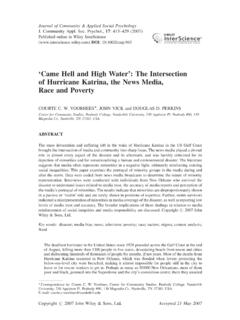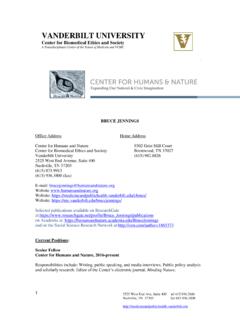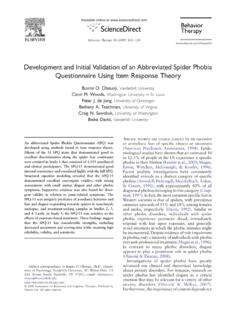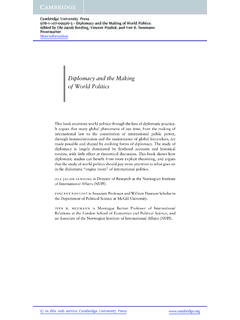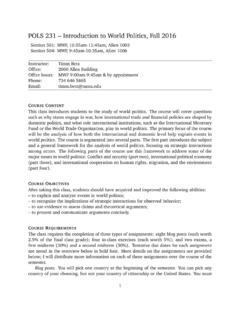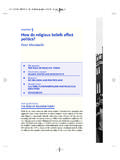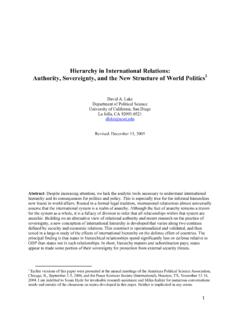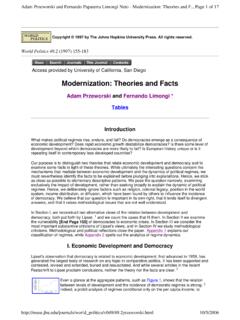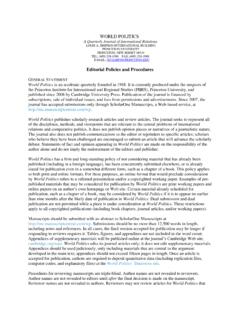Transcription of INTEGRATING LEVELS OF ANALYSIS IN WORLD POLITICS
1 INTEGRATING LEVELS OF ANALYSIS IN WORLDPOLITICSJ ames Lee RayABSTRACT LEVELS of ANALYSIS problems can involve issues regarding (1) the relativepotency of different categories of explanatory factors, (2) the relationshipbetween analyses focusing on different units of ANALYSIS or (3) the relation-ship between assumptions about individual social entities and hypothesesregarding interactions among those entities. An ANALYSIS of the manner inwhich economists have dealt with LEVELS of ANALYSIS issues and recent develop-ments in the field of international POLITICS focusing on the relationshipbetween regime types and international conflict can facilitate the integrationof research efforts involving different LEVELS of ANALYSIS .
2 Advocates of demo-cratic peace rely increasingly on an assumption that leaders of states placethe highest priority on staying in power. This assumption offers a useful basisfor the integration of domestic as well as international or environmentalexplanatory factors. Since this assumption and theoretical notions based onit imply that different types of states behave differently, however, it can alsocomplicate the ANALYSIS of interactions among states. Directed dyadic levelanalyses, and analyses of more complex aggregates using directed dyads asbuilding blocks, can produce data that are more germane to the evaluationof hypotheses regarding the impact of differences between states than aggre-gate level analyses that typically tend to obscure who does what to whom.
3 KEY WORDS democratic peace directed dyads interstate conflict LEVELS of ANALYSIS regime type IntroductionDebate regarding the LEVELS of ANALYSIS problem in the field of internationalpolitics in the post Second WORLD War era began to take shape in a bookwhere the issue is never mentioned specifically. In Man, The State, and War,Waltz (1954, 1959: 160) refers to images , by which he means different cat-egories of factors that cause war, namely the characteristics or attributes ofindividual human beings, states and the international system.
4 He empha-sizes the impact of the structure of the international system as a cause ofwar, but he does not ignore the other two images, nor does he find it diffi-cult to formulate explanations simultaneously INTEGRATING factors pertainingto all three images (Waltz, 1954, 1959: 238).However, some analysts of international POLITICS see the origins of theJournal of Theoretical POLITICS 13(4): 355 388 Copyright 2001 Sage Publications0951 6928[2001/10]13:4; 355 388; 019103 London, Thousand Oaks, CA and New Delhi02lee ray (ds) 23/7/01 3:15 pm Page 355debate about LEVELS of ANALYSIS problems in Singer s (1961) article TheLevel-of- ANALYSIS Problem in International Relations.
5 1 Singer s view oflevels of ANALYSIS issues is fundamentally different from Waltz s. While Waltzfocuses on categories of explanatory factors, Singer refers primarily to thesocial entity or aggregation about which descriptions, explanations or pre-dictions are offered in a given study. In a discussion of the relationshipbetween propositions about foreign policies, on the one hand, and inter-national POLITICS , on the other, he concludes that one could not add thesetwo kinds of statements together to achieve a cumulative growth of empiri-cal generalizations and that representing different LEVELS of ANALYSIS .
6 They would defy theoretical integration (Singer, 1969: 29; emphasis added).2To this day, international POLITICS specialists use the term LEVELS of analy-sis to refer, in Waltzian fashion, to different categories of explanatoryfactors or, following Singer, to different social entities or aggregations astargets for ANALYSIS . Russett et al. (2000: 11), for example, define LEVELS ofanalyis as points on an ordered scale of size and complexity . They go onto explain that a level may refer to the actors themselves, to the states orindividuals whose actions we are trying to explain, or.
7 To different kindsof influences on those actors .Such a definition is, perhaps, a defensible accommodation to usage of theterm within the field of international POLITICS . It is also, however, ambigu-ous on key points. First, it obscures the fact that some units of ANALYSIS areaggregations that do not themselves act or behave. The internationalsystem, for example, can serve as a unit of ANALYSIS , but it has no purposesor goals, nor does it exhibit any behavior that might serve as a target forexplanatory efforts.
8 Furthermore, Russett et al. s (2000) definition of levelsof ANALYSIS can obscure the fundamental difference between the issueregarding the relative impacts of different categories of explanatory factorson the behavior of states or policymakers and the quite different issueregarding the relative merits of and relationships between analyses focus-ing on the behavior or the operation of different social entities or the most important reason why it is important to avoid blurringthis distinction between LEVELS of ANALYSIS
9 As the loci of explanatory factors,on the one hand, and as different social entities whose behavior or opera-tion is being analyzed has to do with issue of INTEGRATING LEVELS of LEVELS of ANALYSIS are nothing more than different locations of explana-tory factors, then they can be integrated simply by including variables from356 JOURNAL OF THEORETICAL POLITICS13(4)1. Reprinted in Rosenau (1969). The place of this article in the view of one sector of the fieldis reflected in the assertion that in a well-known article, J.
10 David Singer introduced the ideaof LEVELS of ANALYSIS (Russett et al., 2000: 11).2. As Levy (1998: 144) observes specifically about this assertion, Singer s statement makessense only if the LEVELS of ANALYSIS are conceptualized in terms of the dependent variable. 02lee ray (ds) 23/7/01 3:15 pm Page 356different LEVELS of aggregation as explanatory factors in one s LEVELS of ANALYSIS in this fashion is relatively simple to relationship between and the integration of analyses focusing ondifferent social entities, by contrast, are more problematic.



